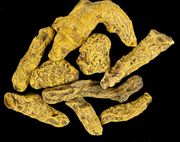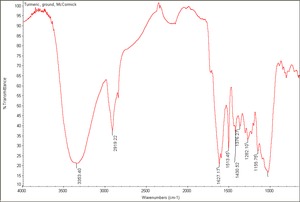Difference between revisions of "Turmeric"
| (3 intermediate revisions by the same user not shown) | |||
| Line 1: | Line 1: | ||
| − | [[File: | + | [[File:MFA1980282 Turmeric.jpg|thumb|Tapis dyed with turmeric<br>MFA# 1980.282]] |
== Description == | == Description == | ||
| − | + | [[File:13 Turmeric root.jpg|thumb|Turmeric ''Ukon'' rhizomes]] | |
| − | A natural yellow or brown dye obtained from the root the ''Curcuma domestica'' (or ''C. longa'') plant native to India and southeast Asia. Turmeric was used in Polynesia as a textile and skin dye. It was known in Mesopotamia and used by the ancient Greeks and Romans. When it was imported to Europe is 1612, it became a popular yellow dye for [[silk]] scarves. The roots are dried then powdered for sale. The primary color component in turmeric is curcumin. It is a water-soluble dye that forms a bright yellow color on [[cotton]] without a [[mordant]]. Darker orange to brown shades are produced with [[alum]], [[ tin]], [[chromium | + | A natural yellow or brown dye obtained from the root the ''Curcuma domestica'' (or ''C. longa'') plant native to India and southeast Asia. Turmeric was used in Polynesia as a textile and skin dye. It was known in Mesopotamia and used by the ancient Greeks and Romans. When it was imported to Europe is 1612, it became a popular yellow dye for [[silk]] scarves. The roots are dried then powdered for sale. The primary color component in turmeric is curcumin. It is a water-soluble dye that forms a bright yellow color on [[cotton]] without a [[mordant]]. Darker orange to brown shades are produced with [[alum]], [[ tin]], [[chromium]], and [[copper]] mordants. [[Iron]] mordants produce a dull green shade. The fugitive colorant was also used to make [[yellow pigments]] and to tint varnishes. Turmeric is currently used as a flavoring agent in curry powder and as a yellow colorant in mustard, cheese, [[paper]], [[wood]], and [[wax]]. |
[[File:turmeric_pieces.jpg|thumb|Turmeric]] | [[File:turmeric_pieces.jpg|thumb|Turmeric]] | ||
| Line 10: | Line 10: | ||
[[[SliderGallery rightalign|Turmeric, ground, McCormick.TIF~FTIR (MFA)]]] | [[[SliderGallery rightalign|Turmeric, ground, McCormick.TIF~FTIR (MFA)]]] | ||
| − | == | + | == Risks == |
| + | |||
| + | Color is sensitive to light. Turns red in alkaline and acid solutions. | ||
| + | |||
| + | ThermoFisher: [https://www.fishersci.com/store/msds?partNumber=AC218580100&productDescription=CURCUMIN+98%2B%25%28UV%29+10GR&vendorId=VN00032119&countryCode=US&language=en SDS] | ||
| + | == Physical and Chemical Properties == | ||
Curcumin is soluble in water, ethanol and ether. | Curcumin is soluble in water, ethanol and ether. | ||
| Line 27: | Line 32: | ||
|- | |- | ||
! scope="row"| Melting Point | ! scope="row"| Melting Point | ||
| − | | 183 | + | | 183 C |
|- | |- | ||
! scope="row"| Molecular Weight | ! scope="row"| Molecular Weight | ||
| mol. wt. = 368.39 | | mol. wt. = 368.39 | ||
|} | |} | ||
| − | |||
| − | |||
| − | |||
| − | |||
| − | |||
| − | |||
| − | |||
== Additional Images == | == Additional Images == | ||
| Line 45: | Line 43: | ||
File:turmeric_powder.jpg|Ground turmeric | File:turmeric_powder.jpg|Ground turmeric | ||
File:turmeric.jpg|Turmeric | File:turmeric.jpg|Turmeric | ||
| − | |||
File:13 Turmeric root_detail.jpg|''Ukon'' | File:13 Turmeric root_detail.jpg|''Ukon'' | ||
</gallery> | </gallery> | ||
| − | + | == Resources and Citations == | |
| − | == | ||
* Palmy Weigle, ''Ancient Dyes for Modern Weavers'', Watson-Guptill Publications, New York, 1974 Comment: Gives plant name as Curcuma longa | * Palmy Weigle, ''Ancient Dyes for Modern Weavers'', Watson-Guptill Publications, New York, 1974 Comment: Gives plant name as Curcuma longa | ||
| Line 82: | Line 78: | ||
* Book and Paper Group, ''Paper Conservation Catalog'', AIC, 1984, 1989 | * Book and Paper Group, ''Paper Conservation Catalog'', AIC, 1984, 1989 | ||
| − | * | + | * "Violin Varnish Glossary" at www.violins.on.ca/luthier.vargloss.html - gives plant name as Curcuma longa |
* Tom Rowland, Noel Riley, ''A-Z Guide to Cleaning, Conserving and Repairing Antiques'', Constable and Co., Ltd., London, 1981 | * Tom Rowland, Noel Riley, ''A-Z Guide to Cleaning, Conserving and Repairing Antiques'', Constable and Co., Ltd., London, 1981 | ||
Latest revision as of 10:43, 22 June 2022
Description
A natural yellow or brown dye obtained from the root the Curcuma domestica (or C. longa) plant native to India and southeast Asia. Turmeric was used in Polynesia as a textile and skin dye. It was known in Mesopotamia and used by the ancient Greeks and Romans. When it was imported to Europe is 1612, it became a popular yellow dye for Silk scarves. The roots are dried then powdered for sale. The primary color component in turmeric is curcumin. It is a water-soluble dye that forms a bright yellow color on Cotton without a Mordant. Darker orange to brown shades are produced with Alum, Tin, Chromium, and Copper mordants. Iron mordants produce a dull green shade. The fugitive colorant was also used to make Yellow pigments and to tint varnishes. Turmeric is currently used as a flavoring agent in curry powder and as a yellow colorant in mustard, cheese, Paper, Wood, and Wax.
Synonyms and Related Terms
tumeric (sp, AAT); Curcuma domestica; Curcuma longa; Natural Yellow 3; CI 75300; curcumin; safran des Indes (Fr.); Gelbwurz (Deut.); terra merita (It.); cúrcuma (Esp.); curcuma (Ned., Port.); merita earth; camotilla; haide; halad; Indian saffron; safran d'Inde; souchet; ukon (Jap.); tumerick; turmerech; terre merite; yellow ginger; yellow root; yo-kin
Risks
Color is sensitive to light. Turns red in alkaline and acid solutions.
ThermoFisher: SDS
Physical and Chemical Properties
Curcumin is soluble in water, ethanol and ether.
Fluoresces green.
ISO R105 Lightfastness Classification = 1
| Composition | C21H20O6 |
|---|---|
| CAS | 458-37-7 |
| Melting Point | 183 C |
| Molecular Weight | mol. wt. = 368.39 |
Additional Images
Resources and Citations
- Palmy Weigle, Ancient Dyes for Modern Weavers, Watson-Guptill Publications, New York, 1974 Comment: Gives plant name as Curcuma longa
- R.D. Harley, Artists' Pigments c. 1600-1835, Butterworth Scientific, London, 1982
- Matt Roberts, Don Etherington, Bookbinding and the Conservation of Books: a Dictionary of Descriptive Terminology, U.S. Government Printing Office, Washington DC, 1982 Comment: Gives plant name as Curcuma longa
- John and Margaret Cannon, Dye Plants and Dyeing, Herbert Press, London, 1994
- R.Feller, M.Curran, C.Bailie, 'Identification of Traditional Organic Colorants Employed in Japanese Prints and Determination of their Rates of Fading', Japanese Woodblock Prints, Allen Memorial Art Museum, Oberlin College, Oberlin, 1984
- F. Crace-Calvert, Dyeing and Calico Printing, Palmer & Howe, London, 1876 Comment: Gives plant name as Curcuma longa
- J. Thornton, 'The Use of Dyes and Colored Varnishes in Wood Polychromy', Painted Wood: History and Conservation, The Getty Conservation Insitute, Los Angeles, 1998 Comment: lists Curcuma domestica as currently accepted name; C.longa as former; also C.tinctoria, C.verdiflora as additional names
- Sigma Dyes, Stains and Natural Pigments, Infrared Library, Nicolet, 1991-1995 Comment: OMNIC: formula= C21H20O6, CAS= 458-37-7, plant name as C.longa
- Helmut Schweppe, Schweppe color collection index and information book
- The Merck Index, Martha Windholz (ed.), Merck Research Labs, Rahway NJ, 10th edition, 1983 Comment: entry 9955
- The American Heritage Dictionary or Encarta, via Microsoft Bookshelf 98, Microsoft Corp., 1998
- Colour Index International online at www.colour-index.org Comment: CAS= 458-37-7
- G.S.Brady, Materials Handbook, McGraw-Hill Book Co., New York, 1971 Comment: p. 360
- Ralph Mayer, A Dictionary of Art Terms and Techniques, Harper and Row Publishers, New York, 1969 (also 1945 printing) Comment: Gives plant name as Curcuma longa
- Book and Paper Group, Paper Conservation Catalog, AIC, 1984, 1989
- "Violin Varnish Glossary" at www.violins.on.ca/luthier.vargloss.html - gives plant name as Curcuma longa
- Tom Rowland, Noel Riley, A-Z Guide to Cleaning, Conserving and Repairing Antiques, Constable and Co., Ltd., London, 1981
- Art and Architecture Thesaurus Online, http://www.getty.edu/research/tools/vocabulary/aat/, J. Paul Getty Trust, Los Angeles, 2000






